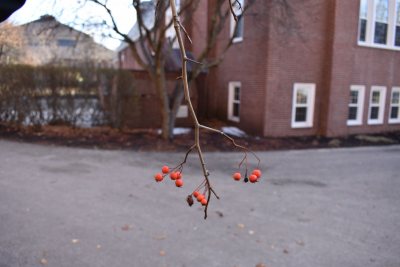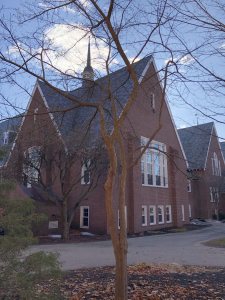Glossy Hawthorn
Crataegus spp. (Crataegus nitida) | Family: Rosaceae
Submission: Sophie Cohen ’22 and Brianna Karboski ’21
Leaves– Alternate, simple, deciduous, serrate and lobed. 2-4 inches long. Dark green above and paler below.
Twigs and Buds– Twigs are slender, grey in color, and armed with an obvious and stiff 1-inch thorn. Buds are globose, round, and red in color.
Fruit/Cone– Fruit is a small pome, yellow to red in color and matures in early fall. Edible fruit, valuable to wildlife.
Bark– Smooth and gray when young, later becoming dark and scaly.
Silvics– Appears as a small tree or shrub that can grow up to 25 feet tall. Intolerant of shade, can be found in woods, beside streams or in abandoned pastures. Often used as an ornamental. Has very hard wood.
Natural History:
Glossy hawthorne (Crataegus nitida) is a species of tree whose name reveals a lot about itself. The word Crataegus, is a derivative of the Greek word “kratos” meaning strength, likely referring to the tree’s durable wood or even its strong medicinal values. Furthermore, the name Hawthorn comes from the old English word “haw”, meaning “hedge”, literally translating to “thorny hedge”, giving reference to the tree’s prominent sharp thorns that cover its twigs. Accordingly, in old England, these trees were planted as hedge bushes to keep people from entering private land.

Glossy hawthorn contains small yellow or red fruits, that look like berries, but are actually pomes. These fruits mature in early autumn and serve as a very valuable food source for many animals including birds, which, upon ingesting the pomes, eventually disperse the seeds. Humans also enjoy the fruit borne on this tree, as they are often made into jellies, jams, and preserves.
Glossy hawthorn is native to northern Europe but is planted as an ornamental in New England. The hawthorn grows along the East Coast, into the mid-Atlantics, and can also be found in the Pacific states. Also known as fairy thorn, shining thorn, and thorn apple, it is a small tree or shrub that typically grows on abandoned fields. Glossy hawthorn’s resistance to pollution also allows it be planted in cities. This tree is very susceptible to hybridization, resulting in many wild and cultivated species of the genus. Because of this, Crataugus is often referred to as a taxonomic nightmare.
Other than helping to produce delicious jellies, jams, and preserves, the fruit of the glossy hawthorn also has highly valuable medicinal properties, which have been used by many cultures for centuries. Hawthorn has been widely accepted in Europe to be a treatment for mild congestive heart failure and is considered to be one of the most important herbs for treating cardiovascular disease. In fact, studies have shown that this plant can help dilate the coronary arteries, increase the integrity of the walls of blood vessels, and reduce fluid buildup in the heart, allowing for the improvement of coronary blood flow and lower blood pressure.
References:
“Crataegus.” Crataegus – an Overview | ScienceDirect Topics, Crataegus nitida – Plant Finder, www.missouribotanicalgarden.org/PlantFinder/PlantFinderDetails.aspxtaxonid=286492&isprofile=0&.
“Hawthorn Tree Facts.” Hunker, www.hunker.com/12320994/hawthorn-tree-facts.
Shane, J. 2004. Dendrology Handbook, University of Vermont, Unpublished.
“Virginia Tech Dendrology.” Virginia Tech Dendrology Fact Sheet, dendro.cnre.vt.edu/dendrology/syllabus/factsheet.cfm?ID=45.
“Yale University.” Hawthorn | Yale Nature Walk, 2 Mar. 2016, naturewalk.yale.edu/trees/rosaceae/cratageus/hawthorn-48.
Tassell M.C., Kingston R., Gilroy D., Lehane M., Furey A. Hawthorn (Crataegus spp.) in the treatment of cardiovascular disease. Pharmacogn. Rev. 2010;4:32–41.
